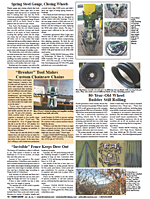2019 - Volume #43, Issue #6, Page #39
[ Sample Stories From This Issue | List of All Stories In This Issue | Print this story
| Read this issue]
From Seed To Store, Herbal Tea Grower Does It All
 |
 |
 |
 |
“This was our third season, and we grew, processed, and packaged 1,500 lbs. of herbal tea,” says DiMaggio. “We have so many flowers growing here, I don’t even know what they all are.”
He starts the season by planting the annuals he needs and mulching and supplementing perennials. He uses hoop houses made from recycled silo rings that are covered in plastic.
“This past spring, I moved 40,000 plants from the greenhouses to a 1 1/2 acre field,” says DiMaggio.
DiMaggio uses a polyculture planting method for most of his plants, mixing them up in groups, rather than leaving them in rows. He believes the diversity improves the soil, and the concentration of so many plants in a small area reduces weeding.
“It’s working out pretty well, but may take 20 years to fully understand,” he says. “I’ve had tremendous yields, but I’m still learning which plants work well together, where they feed in the root zone, and timing.”
Timing is also key to harvest, which DiMaggio determines by the smell of the herb. Everything is cut in small bunches by hand before being cut up on a mechanized, paper cutter refurbished with a food grade surface. The herbs are then laid out on shelves in what he says is the largest herb dryer in the Midwest. He designed and built it himself.
“Each rack is 32 in. wide by 7 ft., 6 in. long for a total of 19 1/2-sq. ft.,” says DiMaggio. “The dryer has 1,000 sq. ft. of surface in total.”
DiMaggio built it big so that when a lot of herbs are at their peak, he can handle them all. He uses a solar heat trap and heat sink to provide the high temperatures needed.
The dryer is in a 12 by 24-ft. building with a concrete floor. A shop with a steeply pitched 35 by 35-ft. roof stands about 15 ft. away. He painted the shop roof black and buried an insulated box with about 9 yards of washed rock in between the 2 buildings. Heat from the shop is pushed through a double-walled culvert pipe into the box or directly to the dryer building. Thermostats control where the heat goes.
“During the hottest days in the summer, the air can get up to 100 degrees, which lowers the relative humidity needed for drying,” explains DiMaggio.
DiMaggio put a lot of time into the solar-powered dryer, but admits payback is slow. Considering the cost of all the components and the energy used for fans, he would go a different and simpler route if starting over.
“I didn’t want to have to buy propane,” he says. “Trying to be cheap can cost more, but I wanted to take advantage of the infrastructure here, and I had no money available to spend on alternatives.”
He also designed and built a motorized shaker table to separate the leaves and flowers from stems. It has two, 24 by 30-in. screens made with food grade plastic and 2 sizes of galvanized screening.
“Most herbal tea companies use a hammer mill to grind up leaves, flowers and stems, which reduces the quality,” says DiMaggio. “I push the cut and dried bunches through the larger screen by hand to remove most of the stems. Then I run leaves and flowers through the shaker table 3 more times for 6 screenings.”
Even then, DiMaggio searches for bits of stem as he packages the screened material for storage in his humidity-controlled, farm house basement.
Once harvest is complete, DiMaggio begins assembling the components for his teas. “When I started, I imagined you would just add a few things together and have a tea,” he recalls. “It took months to try 300 different iterations, mixing them, brewing them, and tasting to get the 3 mixes I sell.”
DiMaggio sells his herbs in quantities of 5 lbs. or more, as well as in mixes packaged in canisters and zip bags through more than 50 retail outlets. A Mylar zip bag holding 7 oz. (100 servings) is priced at $35. A set of 3 canisters, each holding 1.4 oz. (20 servings) is priced at $36. Each mix consists of herbs designed for a specific purpose, whether wakefulness and energy, calm, or to help promote sleep and relaxation.
“We use no flavor additives, just vibrant herbs, flowers and fruit we grow, blended to support health and taste delicious,” says DiMaggio. There’s a video at farmshow.com.
Contact: FARM SHOW Followup, Sacred Blossom Farm, P.O. Box 5, Gilmanton, Wis. 54743 (ph 715 946-3604; Tony@SacredBlossomFarm.com; www.sacredblossomfarm.com).

Click here to download page story appeared in.

Click here to read entire issue
To read the rest of this story, download this issue below or click here to register with your account number.




